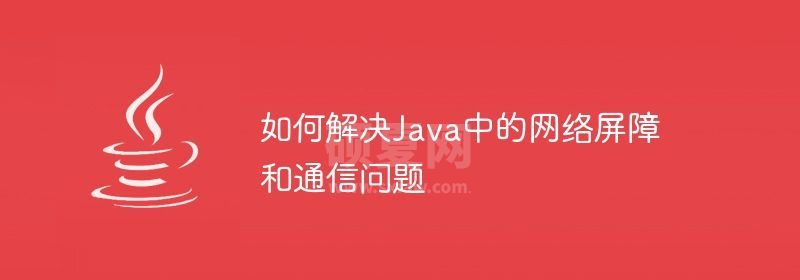如何解决Java中的网络屏障和通信问题

如何解决Java中的网络屏障和通信问题
在Java开发中,网络屏障和通信问题是常见的挑战。在网络通信过程中,可能会遇到连接问题、数据传输延迟、通信异常等。为了解决这些问题,我们可以采用一些方法和技术来优化网络通信的性能和稳定性。本文将介绍一些常见的解决方案,并提供相应的代码示例。
- 使用多线程处理网络通信
在Java中,我们可以使用多线程来处理网络通信,以提高通信的效率和并发性。通过将每个网络请求或连接作为一个独立的线程来处理,可以避免阻塞主线程,提高系统的并发处理能力。
以下是一个简单的示例,演示如何使用多线程处理网络通信:
import java.io.*;
import java.net.*;
public class NetworkThread extends Thread {
private Socket socket;
public NetworkThread(Socket socket) {
this.socket = socket;
}
public void run() {
try {
// 处理网络通信逻辑
// ...
} catch (IOException e) {
// 处理异常
e.printStackTrace();
} finally {
// 关闭socket连接
try {
socket.close();
} catch (IOException e) {
e.printStackTrace();
}
}
}
}
public class Server {
public static void main(String[] args) throws IOException {
ServerSocket serverSocket = new ServerSocket(8080);
while (true) {
Socket socket = serverSocket.accept();
NetworkThread networkThread = new NetworkThread(socket);
networkThread.start();
}
}
}- 使用非阻塞I/O
Java提供了非阻塞I/O(NIO)的方式来处理网络通信,可以提高系统的性能和资源利用率。NIO基于事件驱动模型,使得网络IO操作可以异步进行,当有可读或可写的数据时,会触发相应的事件并进行相应的处理。
以下是一个简单的示例,演示如何使用NIO处理网络通信:
import java.io.*;
import java.net.*;
import java.nio.*;
import java.nio.channels.*;
public class Server {
public static void main(String[] args) throws IOException {
ServerSocketChannel serverSocketChannel = ServerSocketChannel.open();
serverSocketChannel.bind(new InetSocketAddress(8080));
serverSocketChannel.configureBlocking(false);
Selector selector = Selector.open();
serverSocketChannel.register(selector, SelectionKey.OP_ACCEPT);
while (true) {
selector.select();
for (SelectionKey selectionKey : selector.selectedKeys()) {
if (selectionKey.isAcceptable()) {
SocketChannel socketChannel = serverSocketChannel.accept();
socketChannel.configureBlocking(false);
socketChannel.register(selector, SelectionKey.OP_READ);
} else if (selectionKey.isReadable()) {
SocketChannel socketChannel = (SocketChannel) selectionKey.channel();
ByteBuffer buffer = ByteBuffer.allocate(1024);
int bytesRead = socketChannel.read(buffer);
if (bytesRead > 0) {
// 处理读取的数据
buffer.flip();
byte[] bytes = new byte[buffer.remaining()];
buffer.get(bytes);
System.out.println("Received: " + new String(bytes));
buffer.clear();
} else if (bytesRead == -1) {
socketChannel.close();
}
}
}
selector.selectedKeys().clear();
}
}
}- 使用消息队列进行异步通信
当网络通信的速度和数据量较大时,为了提高系统的吞吐量和响应时间,可以使用消息队列来进行异步通信。通过将消息发送到队列中,可以在不同的线程中进行处理,以避免网络通信的阻塞和延迟。
以下是一个简单的示例,演示如何使用消息队列进行异步通信:
import java.util.concurrent.*;
public class Producer implements Runnable {
private BlockingQueue<String> queue;
public Producer(BlockingQueue<String> queue) {
this.queue = queue;
}
public void run() {
try {
// 模拟网络通信
Thread.sleep(1000);
String message = "Hello World!";
queue.put(message);
} catch (InterruptedException e) {
e.printStackTrace();
}
}
}
public class Consumer implements Runnable {
private BlockingQueue<String> queue;
public Consumer(BlockingQueue<String> queue) {
this.queue = queue;
}
public void run() {
try {
String message = queue.take();
// 处理接收到的消息
System.out.println("Received: " + message);
} catch (InterruptedException e) {
e.printStackTrace();
}
}
}
public class Main {
public static void main(String[] args) {
BlockingQueue<String> queue = new ArrayBlockingQueue<>(10);
Thread producerThread = new Thread(new Producer(queue));
Thread consumerThread = new Thread(new Consumer(queue));
producerThread.start();
consumerThread.start();
}
}通过使用多线程处理网络通信、非阻塞I/O和消息队列等技术,我们可以解决Java中的网络屏障和通信问题。这些方法可以提高系统的并发性、性能和稳定性,使得网络通信更加可靠和高效。当然,在具体的应用场景中,我们还需要根据具体的需求和性能要求来选择合适的解决方案。希望本文提供的代码示例能对您有所帮助。
以上就是如何解决Java中的网络屏障和通信问题的详细内容,更多请关注其它相关文章!
